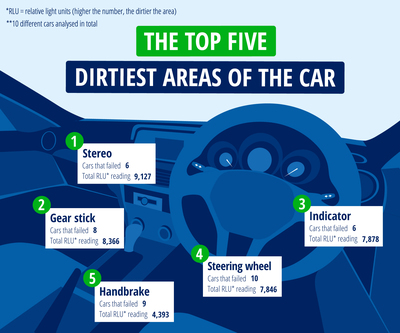New study reveals the dirtiest parts of car interiors
The dirtiest parts of your car revealed
We swabbed ten key touchpoints in ten different cars, and our data reveals that the top dirtiest places inside your car are the stereo and gearstick.
Having scored high for relative light units (RLU) – a test for grubbiness – both of these areas are dirtier than other areas of a car, and are prime places for us to touch when sat behind the wheel, whether it’s to change the radio station or shift up a gear. The problem is that every time you brush your fingers against them, you’re transferring bacteria, oil and grease onto them. If you fail to clean them regularly, then the build-up continues, and you’ve soon got yourself a hotspot for germs.
The indicator and steering wheel are close behind, with the hand brake coming in at fifth place.
To avoid these unhygienic hotspots, make sure you clean the interior of your car regularly, using chemical cleaning products, microfibre cloths, and a vacuum cleaner.
How to keep your car in tip-top condition
Making sure your car is safe to drive should always be your number one concern. These tips will help you to avoid any potential accidents on the road.
Keep your windshield dirt-free
A bug-splattered, dirty, and dusty windscreen is a real safety hazard, as it can make it harder for you to see the road. A quick spray of washing fluid isn’t enough – once a week or after a lengthy car journey, lift your windscreen wipers, douse your windshield in cleaning fluid, and wipe it with a squeegee, moving it from top to bottom.
Pump your tyres
If your tyres are over or under-inflated, they’re at risk of overheating and premature wear. The worst-case scenario is your tyres experience a blowout, which could result in a crash. Make sure you check your tyre pressure at least every month when filling up with fuel, so you can sort out any minor issues before they become a big problem.
Stick to your car’s service schedule
Services can be costly, but if you don’t get your car regularly checked, not only will it cost you more in the long term, it could put yours – and others’ – lives at risk. If your car is more than three-years-old, it should have an MOT every year; and once you’ve driven 10,000 – 12,000 miles, you should send it in for a service.
Keep your oil levels topped up
Motor oil stops the parts of your car’s engine from grinding together, while transferring heat away from the combustion cycle. Checking your car’s oil levels is easy – once the engine is cold, open the bonnet of your car, and find your dipstick. Wipe it clean and insert it into your oil pipe – if your oil levels are near the minimum line on your dipstick, you’ll need to top it up.
If you ever smell a burning smell inside your vehicle, send it to the garage for a check-out immediately.
Treat your car to a good wash
Keeping your car clean shouldn’t just be for vanity purposes – washing your car can help it last longer, too. As you drive, grit and dirt can get into the moving parts of your car, and if they aren’t removed, they can lead to premature wear-and-tear. And bird poo can damage paintwork if left there. Avoid automated car washes in favour of a handwashing company – or just do it yourself. Polishing your car once or twice a year will help protect the paintwork too.
You should also regularly remove any rubbish from the inside of your car, to make sure your pedals remain obstruction-free.
You might think that because you can’t see the dirt, it doesn’t exist – but it’s there! Take the time to clean your car inside and out, to stay safe, save money in the long-term and help your car retain its value



